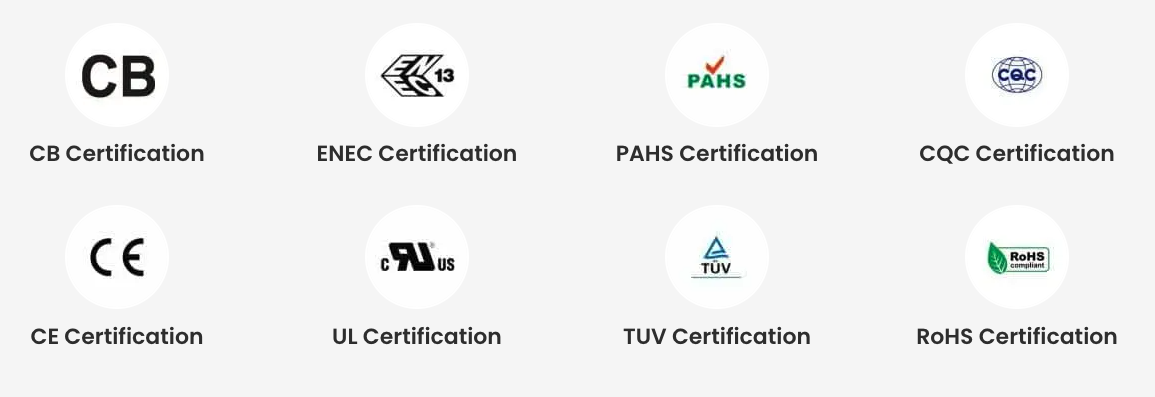In the global marketplace of B2B electrical components, quality assurance and adherence to recognized certifications and standards are not just desirable—they are often mandatory. For B2B procurement professionals and engineers specifying Single Pole Single Throw (SPST) switches, verifying compliance is a critical step in mitigating risk, ensuring product safety, and facilitating market access. Sourcing SPST switches that meet stringent industrial and commercial standards demonstrates a commitment to quality and can protect your business from potential liabilities. This section highlights key certifications and material compliance standards relevant to SPST switches, guiding you in making informed and responsible sourcing decisions.
Various international and regional bodies set safety and performance standards for electrical components, including SPST switches. While the specific certifications required can vary by market and application, some are widely recognized and indicate a certain level of quality and safety testing. When evaluating SPST switch suppliers, look for evidence of the following key certifications:
- UL (Underwriters Laboratories):A globally recognized safety certification organization, particularly prominent in North America. UL Listed or UL Recognized SPST switches have undergone rigorous testing to meet specific safety standards. This is often a crucial requirement for electrical components used in products sold in the US and Canada.
- CE (Conformité Européenne):The CE marking indicates that an SPST switch conforms with health, safety, and environmental protection standards for products sold within the European Economic Area (EEA). It is a mandatory marking for many electrical components entering the EU market.
- CSA (Canadian Standards Association):Similar to UL, CSA develops standards and provides certification services for products sold in Canada and internationally. A CSA mark on an SPST switch signifies compliance with Canadian safety requirements.
- VDE (Verband der Elektrotechnik):The VDE Testing and Certification Institute is a German organization that tests and certifies electrical engineering products, including switches. VDE certification is highly respected in Europe and globally, indicating adherence to stringent safety and quality standards.
Having these certifications on an SPST switch provides assurance that the component has been independently tested and meets established benchmarks for safety and performance, a vital consideration for B2B procurement.

Material Compliance: RoHS, REACH, and Conflict Minerals
Beyond operational safety, environmental responsibility and ethical sourcing are increasingly important in B2B supply chains. Several regulations govern the materials used in electrical components like SPST switches:
- RoHS (Restriction of Hazardous Substances):The RoHS directive, originating in the EU, restricts the use of specific hazardous materials (e.g., lead, mercury, cadmium) in electrical and electronic equipment. Sourcing RoHS compliant SPST switches is essential for products intended for the EU market and is increasingly adopted as a global standard for environmental best practice. This is a key checkpoint for B2B procurement focused on sustainability and market access.
- REACH (Registration, Evaluation, Authorisation and Restriction of Chemicals):Another EU regulation, REACH aims to improve the protection of human health and the environment from risks posed by chemicals. Suppliers of SPST switches may need to provide information on the presence of Substances of Very High Concern (SVHCs) as defined by REACH.
- Conflict Minerals Compliance:Regulations in the US (Dodd-Frank Act Section 1502) and increasingly in other regions require companies to determine if certain minerals (tin, tantalum, tungsten, and gold – often referred to as 3TG) used in their products originate from conflict-affected regions. Responsible SPST switch suppliers should have processes in place to ensure their supply chains are free from conflict minerals, promoting ethical sourcing.
Ensuring your SPST switch supplier adheres to these material compliance standards is crucial for environmental stewardship, corporate social responsibility, and maintaining access to key global markets.
Our Commitment to Quality Assurance (Example for a supplier – can be generalized)
Choosing an SPST switch supplier who demonstrates a strong commitment to quality assurance is fundamental. Look for suppliers who implement robust quality control (QC) processes throughout their manufacturing operations. This might include:
- Incoming material inspection.
- In-process quality checks during assembly.
- 100% functional testing or rigorous sample testing of finished SPST switches.
- Regular calibration of testing equipment.
- Adherence to international quality management system standards like ISO 9001.
A supplier’s dedication to quality assurance directly translates to the reliability and consistency of the SPST switches you procure, minimizing the risk of defects and ensuring the long-term performance of your industrial or commercial products. When engaging in B2B procurement, always inquire about the supplier’s quality management practices and certifications.
By prioritizing SPST switches that meet relevant certifications and standards, and by partnering with suppliers committed to quality and ethical sourcing, B2B companies can build safer, more reliable, and more sustainable products, ultimately enhancing their brand reputation and customer trust. ## H2: Integrating SPST Switches: Design Considerations and Best Practices


